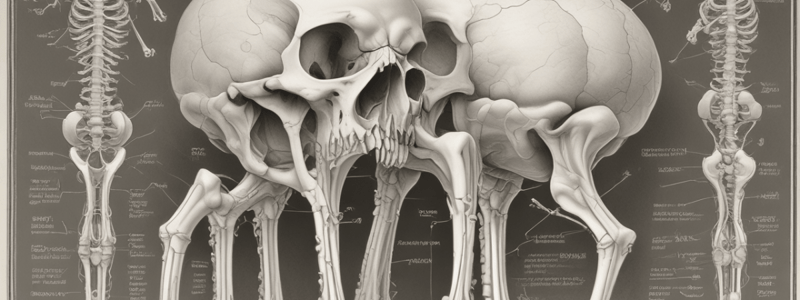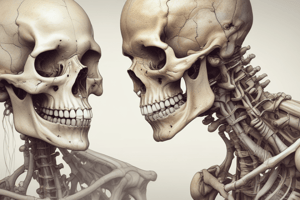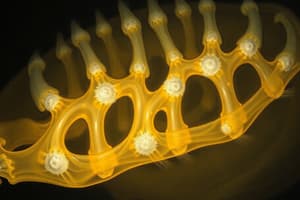Podcast
Questions and Answers
What is the primary function of intramembranous ossification?
What is the primary function of intramembranous ossification?
- Development of joint cartilage
- Regulation of longitudinal growth
- Formation of long bones
- Growth in width of bones (correct)
Which type of ossification is responsible for the formation of the cranial vault and facial bones?
Which type of ossification is responsible for the formation of the cranial vault and facial bones?
- Intramembranous ossification (correct)
- Longitudinal bone growth
- Endochondral ossification
- Appositional bone growth
What type of fracture occurs due to repetitive mechanical stress?
What type of fracture occurs due to repetitive mechanical stress?
- Pathological fracture
- Myositis ossificans
- Stress or fatigue fracture (correct)
- Fracture healing
What is the main difference between articular cartilage and growth plate cartilage?
What is the main difference between articular cartilage and growth plate cartilage?
What is the primary component of soft callus in fracture healing?
What is the primary component of soft callus in fracture healing?
What is the result of the osteoclasts' action in endochondral ossification?
What is the result of the osteoclasts' action in endochondral ossification?
What is the result of reprogramming of stem cells in myositis ossificans?
What is the result of reprogramming of stem cells in myositis ossificans?
What is the term for a break in bone integrity due to mechanical injury or diminished bone strength?
What is the term for a break in bone integrity due to mechanical injury or diminished bone strength?
What is the final stage of fracture healing after several months of remodeling?
What is the final stage of fracture healing after several months of remodeling?
What is the term for the formation of tissue where normally these elements are not seen?
What is the term for the formation of tissue where normally these elements are not seen?
Flashcards are hidden until you start studying
Study Notes
Ossification
- There are two ways of ossification: intramembranous and endochondral ossification
- Intramembranous ossification is a direct bone formation without a cartilage step, seen mainly in bone growth in width (appositional bone growth)
- It includes the cranial vault, facial bones, clavicles, and cortical bone
Intramembranous Ossification
- Occurs when bone needs to grow in width
- Involves the formation of cortical bone
Endochondral Ossification
- Starts with a hyaline cartilage bone model
- Chondrocytes become hypertrophic and die, creating space for blood vessels to develop
- Stem cells for osteoblasts and osteoclasts are formed, leading to the primary ossification center
- Osteoclasts remove cartilage, replaced by true bone via osteoblasts
- Creates the medullary cavity and secondary ossification centers
- Found in axial and appendicular skeleton, responsible for longitudinal bone growth
Regulation of Longitudinal Growth
- Regulated in two ways: paracrine regulation and systemic regulation
- Will be discussed later
Endochondral Bone Formation
- Found in joint cartilage and fracture healing
- Responsible for longitudinal bone growth
Differences between Articular and Growth Plate Cartilage
Articular Cartilage
- Found at the distal ends of bones
- Responsible for joint formation and motility, weight bearing, and resistant to resorption
- Diseases: osteoarthritis (arthrosis)
Growth Plate Cartilage
- Entrapped between epiphyseal and metaphyseal bone
- Responsible for longitudinal bone growth
- Disappears at the end of puberty
- Diseases: growth disorders
Non-neoplastic Pathology of Bone
Bone Fracture
- Loss of bone integrity due to mechanical injury and/or diminished bone strength
- Types: normal fracture (due to acute trauma), stress or fatigue fracture (due to repetitive mechanical stress), and pathological fracture (in weakened bone due to pre-existing lesion/tumor)
Fracture Healing
- Involves the formation of a callus, a hard mass of skeletal repair tissue that unites the fractured bone ends
- Stages: inflammatory stage, formation of granulation tissue, formation of soft callus, and remodeling to form lamellar bone
Myositis Ossificans
- Formation of bone within muscle
- Can occur after hemorrhage or tissue injury, due to metaplasia (formation of tissue where normally not seen)
- Result of reprogramming of stem cells, similar to fracture healing with proliferation of fibroblasts, infiltration of immune cells, and zonal architecture
Studying That Suits You
Use AI to generate personalized quizzes and flashcards to suit your learning preferences.




